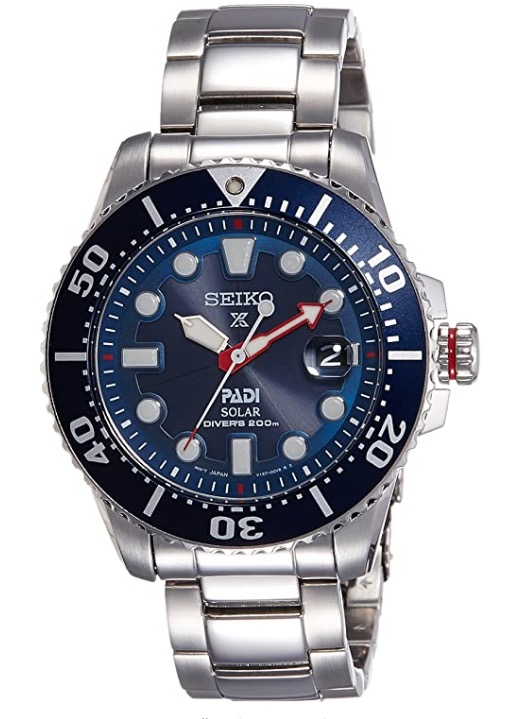A fine and inexpensive timepiece.

The Seiko PADI Solar Model SNE435P1
A friend is an expert on watches and helped me with the decision to buy an inexpensive yet robust timepiece. I have got tired of inflicting damage on costly Swiss timepieces and the related maintenance agonies which last seemingly forever. Last time my Patek Philippe Nautilus was in for replacement of a broken bracelet clasp the service took – wait for it – 9 months.
The Seiko PADI (Professional Association of Diving Instructors) diver’s watch uses a quartz movement, charging its battery through solar cells embedded in the dial. These are so skillfully hidden as to be invisible to the naked eye, and will recharge from any light source. Once fully charged the watch will run for 10 months, according to the manufacturer.
The watch’s appearance is a rip off of the Rolex Submariner with two differences. It’s quartz, not automatic, so far more accurate. And the rotating bezel is screen printed like earlier Submariners. Later ones are enameled for greater longevity.
This is an excellent watch for the rider of a classic motorcycle which has no clock installed. Like my 1975 BMW R90/6 air cooled twin. That’s because the visibility of the hands is very high, requiring only a quick glance at speed and meaning that you do not have to angle your wrist this way and that for a reading.
After many days of checking – you can freeze the seconds hand when setting the watch against a know accurate time source like Apple – the watch is dead accurate, having neither gained or lost as much as one second. The only time you are going to be adjusting the time is at the end of short months when the crown is rotated to advance the date. By contrast the Rolex is guaranteed to +/- 2 seconds a day, or up to one minute a month, which is disappointing on so costly a timepiece.
The Lumibrite fluorescence of the hands is excellent though it rather fades after 3-4 hours. The outer diameter of the dial is 43.5mm suitable for medium and larger wrists. I has to remove one link for a good fit, as well as setting the clasp on its shortest of four positions.
The bracelet is not, however, Rolex quality, using a mix of stainless stampings and castings. The pin and collar mechanism used to connect links is a horror story necessitating that a small 2mm collar is installed one side as the pin is pushed in from the other after removal of link(s). Chances are your jeweler is clueless and will lose the collar, meaning the bracelet will eventually fall apart. Check out online videos, splash out $5 on a pusher tool and do it yourself. The bracelet rattles off the wrist but is fine once in place. The deployment mechanism uses both a clasp and a push button release as a failsafe. While aftermarket bracelets are available for many Seikos, none has yet been made for this model. They tend to be better quality and use screws, not pins, to connect the links. Typically priced around the $100 mark you can buy ten before approaching the cost of the repair on my Nautilus.
Price is incredibly low for what you get. I paid $300 at Amazon. That’s less than the round trip shipping of your Rolex to Geneva when it breaks down, and it will. The happy Seiko owner simply recycles his PADI and buys a new one. He is also $15,000 richer, money which can be spent on scuba gear and lessons.
Fans of automatic movements can spend $50-100 more for the Automatic Turtle (SRPA21J1) or the Automatic PADI (SRPA21) which will get you less accuracy and a short 41 hour power reserve. Replacement aftermarket bracelets for those models are readily available. All are guaranteed leakproof down to 200 meters (660 feet).
The Solar has a date only display with a cyclops magnifier for better visibility. The Automatic PADI and Turtle have day and date displays, unmagnified. Accuracy of the automatic watches is specified by Seiko (4R36 movement) as +45/-35 seconds a day which is, frankly, awful, but can probably be tuned for better performance. None of these qualifies as a ‘dress’ watch, but as I gave away all my suits and ties years ago, ask me if I care.
Highly recommended.
Update after one month of use:
The Seiko gained just 3 seconds. Given that the date has to be advanced mostly every other month, I’ll simply ‘hack’ it at that time to lose the 3 seconds or so it has gained.